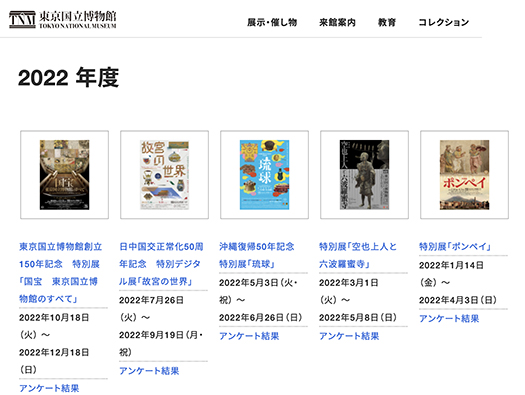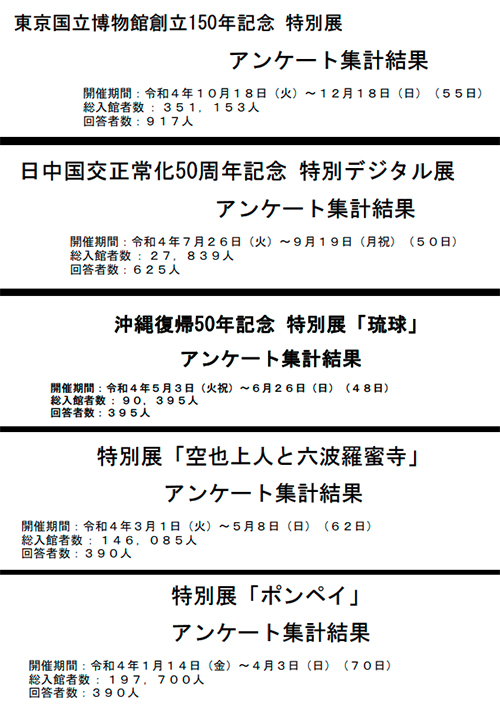

さてブログでほぼ毎日書き続けるのに一定のテーマ特定は不可欠なので、人と住まいという大テーマの範囲内でテーマ特定して書き続けています。そのうちにこういったテーマ毎に串刺しして「まとめ」にチャレンジもしたいのですが、時間が取れない(泣)。連載の「古代メキシコ」篇はテオティワカン文化の終了にあわせ本日はいったん休載。
テーマで大きなウェートを占めるのはやはり歴史と人間文化。住まいはひとの暮らしのイレモノであり、その主体の観念世界との関係性がいちばんの領域になっていくのが自然。結局は人間の興味がすべてを決定していく。
そんなことを考え続けていると、よく行く東京国立博物館での展示テーマ構成というものには「現代人の興味分野、その文化面」のひとつのバロメーターではと思っています。
札幌と距離は離れた東京・上野だけれど、比較的に出張機会も多いので時間を見て足を運んでいる。
で、考えて見ると博物館側が選択する特別展のバラエティには、それが特に「国立」であることもあって、現代日本人意識の一断面が表れるものでしょう。さらに言えば、そういう特別展の「総入場人数」には現代ニッポンの人間の考え方・率直な意識が表れるのではないか。
そんなことで、2022年・昨年の特別展のデータを参照してみたのが、上の画像データであります。入場人数のデータを拾ってみると以下の通り。(同館の展示会表示順)
1 東京国立博物館150周年記念特別展 351,153人
2 日中国交50周年記念特別展 27,839人
3 沖縄復帰50周年「琉球」特別展 90,395人
4 特別展「空也上人と六波羅蜜寺」 146,085人
5 特別展「ポンペイ」 197,700人
各展示会毎で若干開催日には長短がある。最低48日から最長70日という幅。カレンダーとの見合いなどいろいろな条件があるのでしょうが、おおむね2ヶ月が単位になっているようです。
さすがに「東京国立博物館のすべて」みたいな展示会が最高の動員。またわたしも参観して写真撮影OKだったのでブログで古代ヨーロッパの住環境として取り上げた「ポンペイ展」がなかなかの動員ぶり。
「空也上人と六波羅蜜寺」というややマニアックな展示も健闘を見せている。沖縄の復帰50周年は国内有数の観光地域であり、多くの国民が実際に観光訪問していることを考えれば、テーマ設定自体にハンディがあったのかも知れない。
そういうなかで最もふるわなかったのが日中国交50周年記念特別展。わたしは「ふ〜む、中国かぁ」と多少残念感は持ちつつも律儀に参観した。ちなみに2022年に訪問出来たのはポンペイとこちらの展示会の2回のみ。デジタル技術で紫禁城に「まるで実際に行っているような」という展示が目玉だったんですが、閑散とした人数にむしろ驚かされておりました。
どうも現代ニッポン人の率直な気分が表現されているようですね。
English version⬇
Comparison of the attendance at the Tokyo National Museum’s Special Exhibitions in FY2022
The Pompeii exhibition was very interesting and I wrote a series of in-depth articles about it on my blog, but the China exhibition, which I was able to visit, was very deserted. The Chinese exhibits, which I was able to visit, were deserted.
I have been writing almost every day on my blog, and it is essential for me to identify a certain theme, so I have been writing on a specific theme within the broad theme of people and their homes. I would like to write a “summary” of each theme, but I can’t find the time (I cry). The “Ancient Mexico” section of the series is temporarily on hiatus today, as the Teotihuacan culture has come to an end.
History and human culture are the main themes of the series. A house is a part of people’s lives, and its relationship to the world of ideas is the most important area. In the end, human interest determines everything.
In this context, I have been thinking about the exhibition themes at the Tokyo National Museum, which I often visit, as a barometer of “the fields of interest of modern people and their cultural aspects.
Although Sapporo and Ueno are far from each other in Tokyo, I visit the museum when I have time because I have many opportunities to go on business trips.
When I think about it, the variety of special exhibitions selected by museums, especially those that are “national” in nature, may reflect a cross-section of the contemporary Japanese consciousness. Furthermore, the “total number of visitors” to such special exhibitions may also express the way of thinking and frank awareness of contemporary Japanese people.
With this in mind, I referred to the data of last year’s special exhibition in 2022, as shown in the image above. Picking up the data on the number of visitors, we find the following. (in the order of the museum’s exhibition display)
1 Tokyo National Museum’s 150th Anniversary Special Exhibition: 351,153 visitors
2 Special exhibition commemorating the 50th anniversary of Japan-China diplomatic relations: 27,839 visitors
3 Ryukyu Special Exhibition: 50th Anniversary of the Return of Okinawa to Japan 90,395 visitors
4 Special Exhibition “Kuya Shonin and Rokuharamitsuji Temple” 146,085 visitors
5 Special Exhibition “Pompeii” 197,700 visitors
Each exhibition has a slightly different length of time. The range is from a minimum of 48 days to a maximum of 70 days. Although there may be various conditions, such as calendar conflicts, it seems that the unit of time is generally two months.
As one would expect, exhibitions such as “All About the Tokyo National Museum” are the most well attended. I also visited the “Pompeii Exhibition,” which I mentioned in my blog as an ancient European living environment, because I was allowed to take pictures.
The somewhat geeky exhibition “Kuya Shonin and Rokuharamitsuji Temple” also did well. Considering that Okinawa is celebrating the 50th anniversary of its reversion to Japan and is one of the most popular tourist destinations in Japan, and that many of its citizens actually visit Okinawa for sightseeing, the theme itself may have been a handicap.
The least successful of these was the special exhibition commemorating the 50th anniversary of Japan-China diplomatic relations. I was somewhat disappointed, saying, “Hmmm, China, huh? Incidentally, I was able to visit Pohnpei and this exhibition only twice in 2022. The main feature of the exhibition was the use of digital technology to make the Forbidden City “look like you are actually there,” but I was rather surprised at the number of people who visited the deserted site.
It seemed to express the frank mood of modern Japanese people.
Posted on 9月 24th, 2023 by 三木 奎吾
Filed under: 日本社会・文化研究







コメントを投稿
「※誹謗中傷や、悪意のある書き込み、営利目的などのコメントを防ぐために、投稿された全てのコメントは一時的に保留されますのでご了承ください。」
You must be logged in to post a comment.